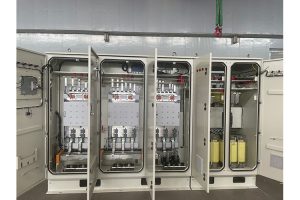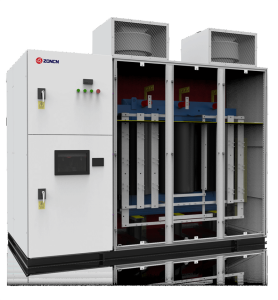I. Types of high-voltage inverters
1. IGBT high-voltage inverter:
The use of insulated gate bipolar transistor (IGBT) as a power switching element with low on-state voltage drop and fast switching speed makes the high-voltage inverter able to reduce energy loss when converting power.IGBT devices have high reliability and durability, and they can meet the requirements of long-time and stable operation in industrial environments, realize precise motor control and monitoring, and improve the intelligence and automation level of the system.
IGBT high-voltage inverter can withstand higher voltage, suitable for medium and high power motor control, widely used in industrial production lines, manufacturing and other fields.
2. SiC high-voltage inverter:
SiC (silicon carbide) high-voltage inverter is a kind of high-voltage inverter that uses silicon carbide (SiC) as the main power semiconductor device. Compared with traditional silicon (Si) power devices, SiC devices have higher electron migration speed and breakdown electric field strength, as well as lower conduction and switching losses, and thus can provide higher operating frequency, higher temperature operating range and higher power density.
SiC high-voltage inverters have a broad development prospect in industrial applications, especially for applications requiring high performance, high-temperature environments and miniaturized designs, such as electric vehicles, wind power generation, solar power generation and rail transportation.
3. Multi-level high-voltage inverter:
Adopting multi-level inverter technology, the output waveform is closer to sinusoidal waveform, reducing harmonics and electromagnetic interference.
It is suitable for fields with high requirements for electromagnetic compatibility, such as medical equipment, aerospace and so on.

Second, the application range of high-voltage inverter
1. Power Industry:
In the power transmission and distribution system, high-voltage inverter can be used to regulate the voltage and frequency and realize the transmission and distribution of electric energy. It can improve the stability and efficiency of the power grid and is suitable for the regulation and optimization of various power systems.
2. Petrochemical Industry:
In the petrochemical industry, high-voltage inverter is used to control pumps, fans and other equipment to realize fluid transmission and compression.
3. Mining And Metallurgy:
In the mining and metallurgy industry, including industrial pumps, fans, compressors, conveyor belts and other equipment speed control and energy-saving operation. High-voltage frequency converter realizes precise control of the motor by adjusting the speed and torque of the motor, and improves the efficiency and performance of the system.
4. Rail Transportation:
In electric trains, subways and other rail transit systems, high-voltage inverters are used to control the speed and torque of electric motors, to realize train operation control and energy recovery, and to improve the energy efficiency and operational stability of rail transit systems.
5. Wind Power Solar Energy:
In the field of renewable energy, high-voltage inverters are used to control wind turbines and solar power generation systems, converting the DC power generated by solar panels into AC power, realizing the conversion of electrical energy and access to the power grid.

